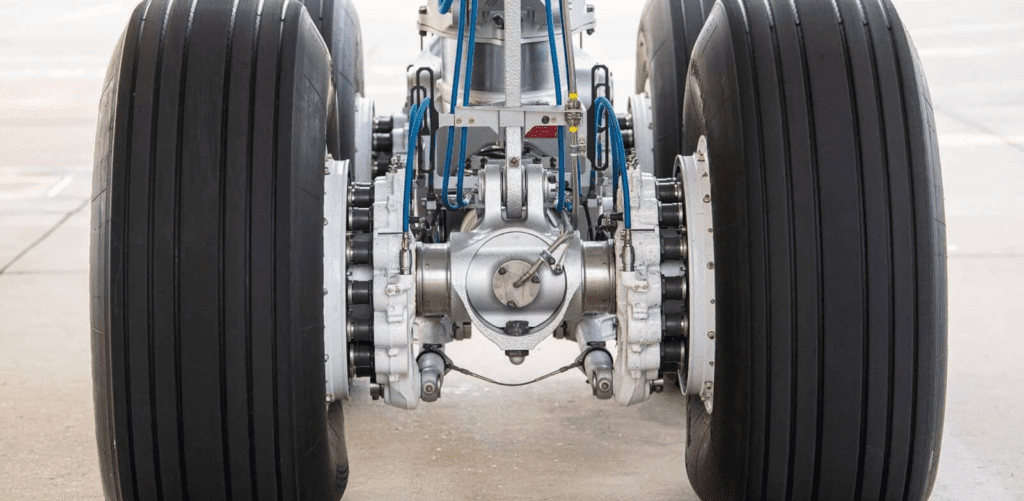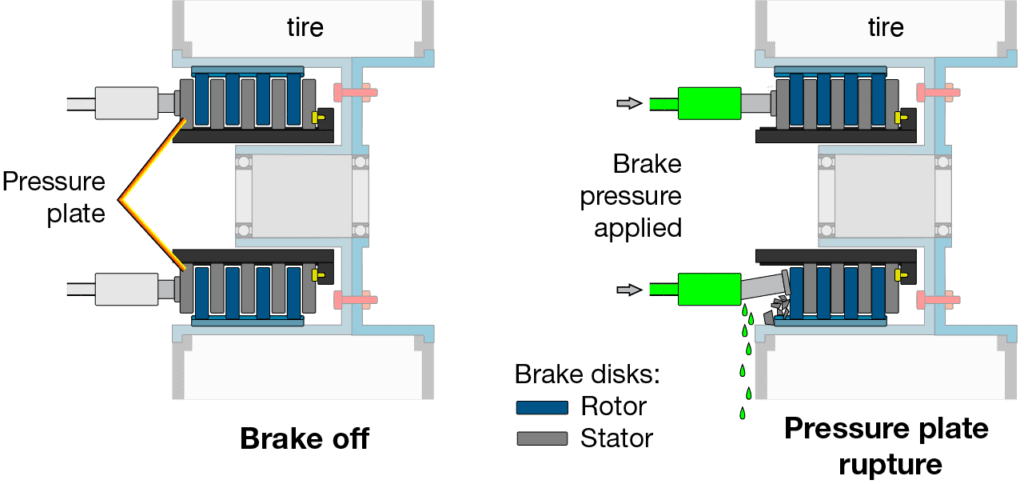
All Brakes are subject to wear. Some brakes may also experience oxidation which can lead to brake rupture. In the case of a brake rupture or if brakes are too worn, the aircraft braking performance is reduced. This can result in a runway overrun if the full braking capacity is required such as during a rejected takeoff with an aircraft weight at or close to the maximum takeoff weight. Brake rupture can also lead to damage that can cause a brake fire due to hydraulic fluid coming into contact with hot parts.
This article describes carbon wear and oxidation phenomena. It recalls the maintenance procedures used to identify worn or oxidized brakes, flight crew procedures, and good practices to prevent brake wear and oxidation.
CASE STUDY
Event Description
Shortly after landing, the flight crew of an A330 aircraft heard a strong and unusual noise during taxi-in. When the aircraft reached the parking stand, ground crew observed smoke coming from the area of the left Main Landing Gear (MLG) and informed the flight crew. The fire brigade arrived but did not see any fire. The flight crew noticed a 400 °C temperature on wheel no. 6. Maintenance personnel performed a quick inspection of the landing gear, which revealed that one of the brake pistons of wheel no. 6 had twisted and dislodged from its housing with evidence of a hydraulic fluid leak (fig.1). There was no sign of fire on the landing gear structure and components.

Event Analysis
The investigation showed the most probable cause was a rupture of the brake pressure plate during brake application. The brake piston pushed through the pressure plate and came into contact with the first rotor (fig.2). This applied a lateral force to the piston causing it to be dislodged from its housing and causing the hydraulic fluid leak. The hydraulic fluid that leaked onto the hot parts of the brake created the smoke. The pressure plate was found to be significantly oxidized, which was the reason it ruptured when the brake piston pressed against it.

BRAKE WEAR VS. BRAKE OXIDATION
Brakes are subject to two different phenomena: Wear and oxidation.
Brake wear
Brake wear is the progressive loss of width on the brake disks due to friction. Brake wear on carbon brakes depends on the number of brake applications and on the brake temperature. Each carbon brake type has its own temperature range for optimum operation and its temperature range for maximum wear. The temperature range varies from one brake manufacturer to another.
Guaranteed braking efficiency until the wear limit
Brakes are guaranteed to provide sufficient braking until the brake wear indicator is flushed with the reference surface. If the indicator is below the reference surface, the brake disks are too worn, and the braking performance can be significantly reduced. If the brake disks are too worn, their width is reduced. As a result, the pistons do not have enough extension to push the disks and create sufficient braking friction to slow down the aircraft (fig.3). In addition, if the brake is too worn, the amount of heat sink mass that is available to absorb braking energy is reduced. In the event of a high speed RTO this can lead to increased risk of runway overrun or brake fire.

Brake oxidation
Carbon from the brakes naturally combines with oxygen from the ambient air to become carbon dioxide (CO2). Under normal circumstances the oxidation occurs at a very slow rate. However the rate of oxidation can be accelerated by external factors such as high temperature and catalytic (chemical) pollution. This results in a loss of carbon mass from the brake disks, carbon softening, and delamination. It can ultimately lead to brake rupture if an affected brake is not changed in due time (fig.4). Carbon oxidation due to exposure to high temperatures is referred to as thermal oxidation. When carbon oxidation is due to the presence of catalysts, it is usually referred to as catalytic oxidation.

Thermal oxidation
Thermal oxidation is the main cause of accelerated degradation of carbon brakes. It can occur if high brake temperatures are reached after landing and during taxi. Thermal oxidation affects all brake disks, but the middle disks are most affected because they reach a higher temperature and take longer to cool down. Worn brakes tend to reach higher temperatures making them more prone to the effects of thermal oxidation.
OPERATIONAL CONSIDERATIONS
The flight crew can detect worn brakes before the flight during the exterior walkaround. They can reduce wear and oxidation by using the brakes in an optimal manner during taxi and landing.
Brake wear indicator check on walkaround
A quick check of the brake wear indicator (fig.9) during the exterior walkaround will determine if the brakes are worn. If there are only a few millimeters remaining before the indicator is flush with the reference plate, inform maintenance personnel to anticipate and plan for a brake replacement before the wear limit is reached. On A220 aircraft, the flight crew can also check the brake wear status on the EICAS STATUS synoptic page.

(fig.9) Brake wear indicator on an A350-1000 aircraft
Reducing brake use during taxi
Flight crews should reduce the number of brake applications during taxi to limit brake wear. The FCTM and A220 FCOM recommend that on long, straight taxiways, and with no ATC or other ground traffic constraints, the PF should allow the aircraft to accelerate to 30 kt of ground speed, and then use one smooth brake application to decelerate to 10 kt.
Keep thrust at idle
Maintaining idle thrust during taxi enables a reduced number of brake applications to keep the aircraft below the 30 kt maximum taxi speed.
Single engine taxi
Single engine taxi is a fuel saving initiative that also reduces brake wear, because it further reduces the idle thrust during taxi.
Reducing braking energy at landing
The number of thermal oxidation reports is increasing, especially on the A320 family fleet. This phenomenon may be linked with efforts by many operators to save fuel. It was observed that a majority of operators reporting high thermal oxidation were using CONF 3 and thrust reversers on IDLE at landing. There is a trade-off between fuel savings, engine maintenance costs, and increased brake replacement due to higher rates of oxidation. This will depend on the flight conditions, aircraft condition, and the operator’s policy.
Use of Flaps FULL (or FLAP 5 on A220)
The use of flaps FULL (FLAP 5 on A220) at landing reduces the approach speed, and therefore, the aircraft energy to be absorbed by the brakes.
Use of autobrake or Brake-to-vacate (BTV) at landing
Use of autobrake or BTV (if installed) enables a single brake application with an optimized braking intensity. When autobrake is used and if conditions permit, the use of autobrake LOW reduces the heat of the brakes, and therefore, reduces the likelihood of oxidation.
Source – safetyfirst.airbus.com





